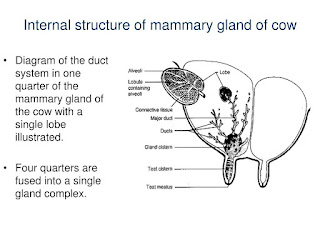Milk
Milk is a nutritious liquid that is produced by mammals that contains proteins, fats, carbohydrates, vitamins, minerals and water. Though all female mammals produce milk, humans consume almost all of their milk from ruminants, mainly cows and buffaloes.
Ruminants are a group of mammals that have a specialized digestive system that allows them to ferment plant-based food in a chamber called the rumen before digesting it. They are able to extract more nutrients from plants than other herbivores by using microorganisms in the rumen.
Female ruminants produce milk because they have mammary glands that are stimulated by hormones during pregnancy and lactation. Male ruminants do not have functional mammary glands, so they cannot produce milk.
Dairy cattle are ruminants, which means they have a four-compartment stomach that allows them to digest fibrous plant materials such as grasses, hay, silage, and grains.
Stomach of Ruminants:
The stomach of ruminants is a complex organ that consists of four compartments: the rumen, the reticulum, the omasum and the abomasum.
The Rumen:
The rumen contains billions of microorganisms, such as bacteria, protozoa, and fungi, that break down the feedstuffs into simpler compounds that can be absorbed by the cow. The microorganisms also produce volatile fatty acids (VFAs), which are the main source of energy for the cow, and essential amino acids, which are the building blocks of protein.
The rumen pH is maintained between 6 and 7 by saliva and bicarbonate, which buffer the acids produced by fermentation. The rumen temperature is between 100 and 108°F, which provides a warm and moist environment for microbial growth.
The Reticulum:
The reticulum is a smaller compartment. The reticulum has a honeycomb-like structure, which gives it the nickname of "honeycomb stomach". It traps foreign objects that may be ingested by the cow, such as metal or stones and helps regurgitate food for further chewing. The smaller particles that are more digested pass through to the next chamber, while the larger particles that need more fermentation are regurgitated back to the mouth for further chewing. This process is called rumination or cud chewing.
The Omasum:
The omasum is the third chamber of the ruminant stomach. It is also called the "manyplies" because of its many folds or layers. The omasum acts as a filter and absorbs water, minerals, and some volatile fatty acids from the food. It also reduces the particle size further before passing it to the final chamber.
The Abomasum:
The abomasum is the true stomach that secretes digestive enzymes and acids to further digest the food.
Role of Stomach in Milk Making:
The digested food then passes to the small intestine, where nutrients are absorbed into the bloodstream. The blood carries the nutrients to various organs, including the mammary glands.
The role of the ruminant's stomach in making milk is to digest and ferment the plant-based food that the ruminant consumes, mainly through the action of microbes.
The Udder:
The udder is a single mass hanging beneath the animal, composed of pairs of mammary glands with protruding teats.
The udder is connected to the stomach by a network of blood vessels, nerves and lymphatic ducts.
The udder is linked with the stomach in several ways.
First, the blood supply of the udder is dependent on the blood flow from the stomach. The blood carries nutrients and hormones that affect milk production and quality.
Second, the nerves of the udder are influenced by the signals from the stomach. The nerves control the contraction of the smooth muscles of the udder, which regulate milk ejection and secretion.
Third, the lymphatic system of the udder is connected to the lymph nodes near the stomach. The lymphatic system drains excess fluid and immune cells from the udder, and also transports antibodies and other immune factors to protect against infections.
The udder and the stomach are therefore closely related organs that affect each other's function and health. A healthy udder requires a healthy stomach, and vice versa.
Conclusion:
The milk making process of ruminants involves a complex digestive system that allows them to extract nutrients. The nutrients are then used in an intricate manner by the mammary glands to produce milk.
Points to Ponder:
From simple grass ruminants after intricate process convert it into poisonous blood that in turns processed into nutritious liquid whose main beneficiary is unrelated third party.
How one can develop such an elaborate system without prior planning and well-defined purpose?
e










Comments
Post a Comment